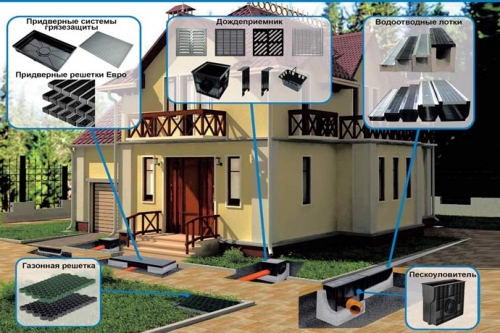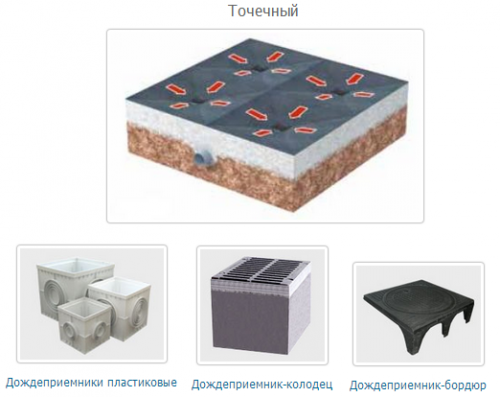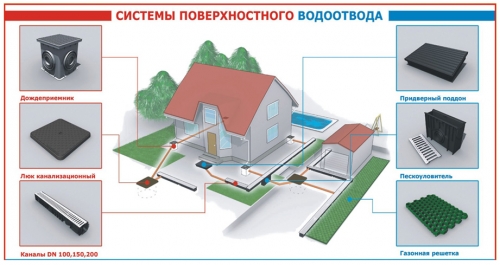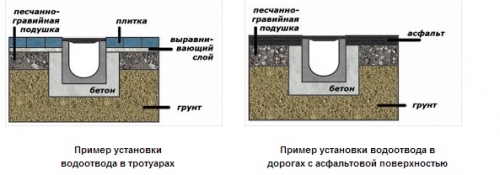The surface purification with the use of sandblasting is called sandblasting ...
|
|
In order to increase the quality characteristics of the cement mortar, to it ... |
Among the highest artistic methods of decorating metal products remains ... |
Superficial drainage - choice of material, installation, instruction
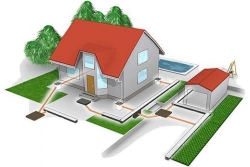
Owners of private areas are increasingly interested in the surface drainage system. This is not surprising, because the properly designed and installed drainage reliably protect the surface relief, the foundation of the house or office from abundant atmospheric precipitation, which can further lead to the death of green spaces, violation of the structure, flooding of the basement or other unpleasant consequences. All types of drainage on the site should be installed comprehensively and combined into a single system, because only in this way they will cope with the set goals without problems. This article will talk about a superficial drainage, its types, correct design and all the nuances of installation.
Table of contents
- Design stage
- Complex drainage system on the site
- Types of surface drainage
- The selection of materials for the installation of a surface drainage
- The main stages of installation of a surface drainage
Design stage
Designing is the most important stage of work in the arrangement of a drain on the site.
A properly designed and qualitatively executed surface system of water drainage will create favorable construction conditions and further operation of all structures.
At the design stage, you should determine the type of water disposal system, draw up a diagram of the location of all channels, water intake points and water discharge points, in addition, it is important to install which materials and in what quantities should be purchased.
When planning the placement of drainage, the density of the channel grid should be taken into account the following:
- the type and hardness of the soil;
- surface type (asphalt, gravel, sand, lawn, etc.);
- groundwater level;
- site plan (placement of household facilities, flower beds, paths and other structures);
- the frequency and intensity of atmospheric precipitation.
For example, if the soil is solid and the surface passes the moisture little, then it is necessary to install a larger number of channels. Additional sleeves will also be needed if there is a difference in the height of the site, as a result of which water will drain from the adjacent side. If you have clay soil and frequent swampiness occurs, then you will have to build underground drainage.
Ultimately, on the basis of the project, a cost estimate will be compiled. As you can see, the system of the system does not require complex design, and the price of a surface drainage is relatively low.
Complex drainage system on the site
The main task of the drainage system in the summer cottage is the protection of the foundations of buildings, basements from moisture, preventing soil erosion, obstacle to the surface of the surface, the appearance of ice in winter and puddles in the summer. It will fulfill all its functions most effectively if the water drainage provides a comprehensive system, the components of which are:
- water drainage system from the roof;
- surface drainage;
- internal drainage of water;
- groundwater removal system;
- drainage ditches.
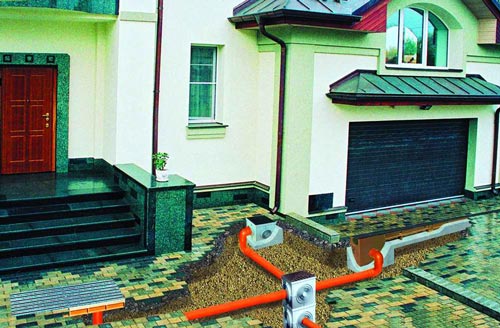
Types of surface drainage
There are two types of superficial systems:
- linear, which performs the functions of collecting rain or meltwater from large areas;
- a point, the purpose of which is the collection of rainwater from the surface.
We will consider each type of surface drainage system in more detail
Linear drainage
The linear drainage is rationally used on the flat surface, when water does not flow into certain places, but is dispersed throughout the site. Such a system is a set of gutters with lattices designed to avoid large garbage. The canals are installed throughout the territory and simultaneously perform two functions: rainers and pipelines.
The main task of the sand receivers is to filter rain water from a variety of debris, for example, earth, sand or small pebbles. They are installed, as a rule, before sewage, which in turn protects it from clogging.
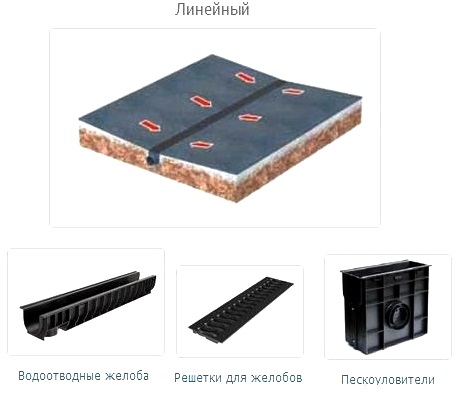
Also in the system of surface drainage, retarded pallets are used to collect dirt from the soles of the shoes, as well as lawn grilles that allow the most effectively water from the site.
The trays should be laid in trenches with a slope of about 5º. In order to be sure that you guessed with a slope, take a powerful stream of water before the installation of the gutters, if the flow moves unhindered to the rain receiver, then you did everything right.
To protect concrete or tile paths on the site, or rather, to avoid waterlogging of their sandy pure, which can subsequently lead to instability of the structure or cracks, drainage trays should be laid on the sides of the coating.
Point drainage
If your site suffers from strong water flows during floods or rainfalls, then it is necessary to install a point drain intended for local water collection. He will cope with this problem without any problems. This type of water collection system will effectively complement the linear system of moisture from the site.
This design is a set of water receivers that are dug into the most problematic zones of the territory. To determine where exactly it is necessary to construct the trays immediately after the rain, mark the most flooded zones with pegs or where puddles do not go for a long time after rainfall.
The water accumulated in the vessels can be further used for household needs or is displayed into the sewage system. For a point drain, plastic rain receivers can be used, or rainiments of the well, a border. On the end walls of the vessel, compounds with a pipe of diameters from 50 to 160 mm are provided.
For the most effective drainage on your site, it is rational to use these two systems correctly.
The selection of materials for the installation of a surface drainage
The selection of the parameters of the drain depends on the large number of factors, for example, such as the coating, the relief of the site, climatic conditions, etc.
The materials necessary for the arrangement of the drainage system:
- shovel necessary for organizing a trench;
- concrete designed to fill the trench;
- gutter, trays and rain receivers - the main part of the entire drainage system;
- a sand receiver that performs the functions of filtering rainwater;
- lattices designed to collect large mechanical impurities.
The durability, efficiency and reliability of the surface drainage system directly depends on the quality of its main elements, therefore their choice should be treated with special responsibility and at the same time take into account the advice of specialists.
Production material
Not only its operational properties, but also the cost of arranging a drainage system on the site depends on the materials of the manufacturing elements of the system. The main components of the drainage system are, of course, trays and rainwear that can be concrete, plastic or polymer concrete. When choosing their material, one should first take into account the purpose of the site where they will be constructed.
- concrete
This type of trays, as a rule, is protected by cast -iron or steel grilles, and is equipped with special mounts, which significantly increases the reliability of the entire system. The main advantages are: moisture resistance, high strength, self -purification. Concrete gutters belong to the middle price category and are able to withstand a load of up to 90 tons.
- plastic
This type of trays is durable, easy to install, has improved, in comparison with concrete, throughput, in addition, is relatively low and low. Plastic trays are not recommended to be used in areas with increased load, since their permissible norm is 25 tons and no more. The exception is only the trays of the class F with steel nozzles and a cast -iron grate.
To protect the site from excess moisture with a small budget, concrete and plastic rainers of the corresponding load class are suitable, while taking into account that plastic trays can be installed in pedestrian areas, and where car transport passes, it is necessary to use concrete.
- polymer concrete
This material of the trays will combine all the advantages of concrete and plastic, it is very durable, moisture -resistant, durable, resistant to dynamic influences, and has excellent throughput. One drawback is a relatively high cost, however, polymer concrete trays are suitable for those who know that the positive qualities of this material of the trays will quickly pay off the increased costs of the drainage basis, since in addition to the main advantages, it has another positive nuance does not lose its technical characteristics even after the expiration of the deadline services.
Railing lattices are steel, galvanized, cast -iron, metal, polymer, plastic and stamped. The most durable and durable are cast -iron lattices, the service life of which is about 30 years, the metal ones will serve you not for more than 10 years, and polymer will have to be changed every 5 years.
Load class
When choosing the main components of the surface drainage, namely, trays and rain receivers, it is necessary to take into account the load class, depending on the required throughput and place of application.
- for the arrangement of pedestrian areas, park plots, squares, products with marking A 1.5 tons are suitable;
- to organize a drain on roads with low and average traffic intensity, it is necessary to choose products with a marking of 12.5 tons and 25 tons, respectively;
- to drain the surface of airports, gas stations, factories, loading terminals, a great option will be the products of class D 40 T and E 60 tons.
For private construction in pedestrian areas, the A15 water lattice should be purchased, and in the parking and travel zone you should choose a class of 125.
The main stages of installation of a surface drainage
- The installation of a surface drainage should begin from digging a trench, the width of which should be twice as wider than the drainage tray. When calculating the size of the trench, the height of the concrete base H should be taken into account, the width of the lateral supports s, the size of the water intake itself and the thickness of the lattice, while taking into account that it should be lower than 3-7 cm from the very coating of the site.
- At this stage of the construction of a drainage, it should be made that the soil will withstand the estimated level of load.
- Then it is necessary to start preparing a trench for sand captures, unless, of course, they are provided in your drainage system. Installation of sand addors is necessary if the drainage system is connected to underground sewage.
- After preparing the trench, you should proceed to pour the concrete base of the M50 m75 brand. The strengthening of the sides is also carried out using concreting. A layer of both slopes and side channels should be at least 10 centimeters. Concrete can be replaced by sand with gravel if traffic is not supposed to be traffic on this coating.
- The next stage is the installation of a sand dwelling in a previously prepared trench.
- Now you can go to the assembly of the drainage system and laying it in the trench. The channels starting with the exhaust opening are attached to the VSTS using a groove on one side and a spont on the other, while there is no need for additional sealing.
- On the water supply vessels, the movement of water should be marked with arrows. This factor is taken into account when laying a water collector.
- If it is necessary to fasten the channels at an angle of their cut, it is performed manually using a file equipped with a diamond disk.
- Connecting the surface discharge of excess water to the sewage system is carried out through the sand dwelling using the D100 pipe, while in advance it is required to pull the final hole from the housing. If the drain is attached to the sewage system without the use of the sand trap, and with the help of vertical pipe, then the hole located on the bottom of the channels must be freed from the plug. To do this, do drill carefully along the contour, and then knock out the plug with a light blow. Insert the pipe into the hole.
- The remaining free space of the trench is covered with earth and crushed stone, while compacting the mixture.
- After that, close the trays with grilles, while the upper soil layer should be 3-6 centimeters above the drainage.
- Point rainers in a similar way using the PVC D100 pipe are connected to the sewage system without affecting the sand dwelling.
- It is important to remember that it is necessary to perform periodic cleaning of the surface drainage system at least 2-3 times a month, while removing the lattices and a filter from the sand trap.

